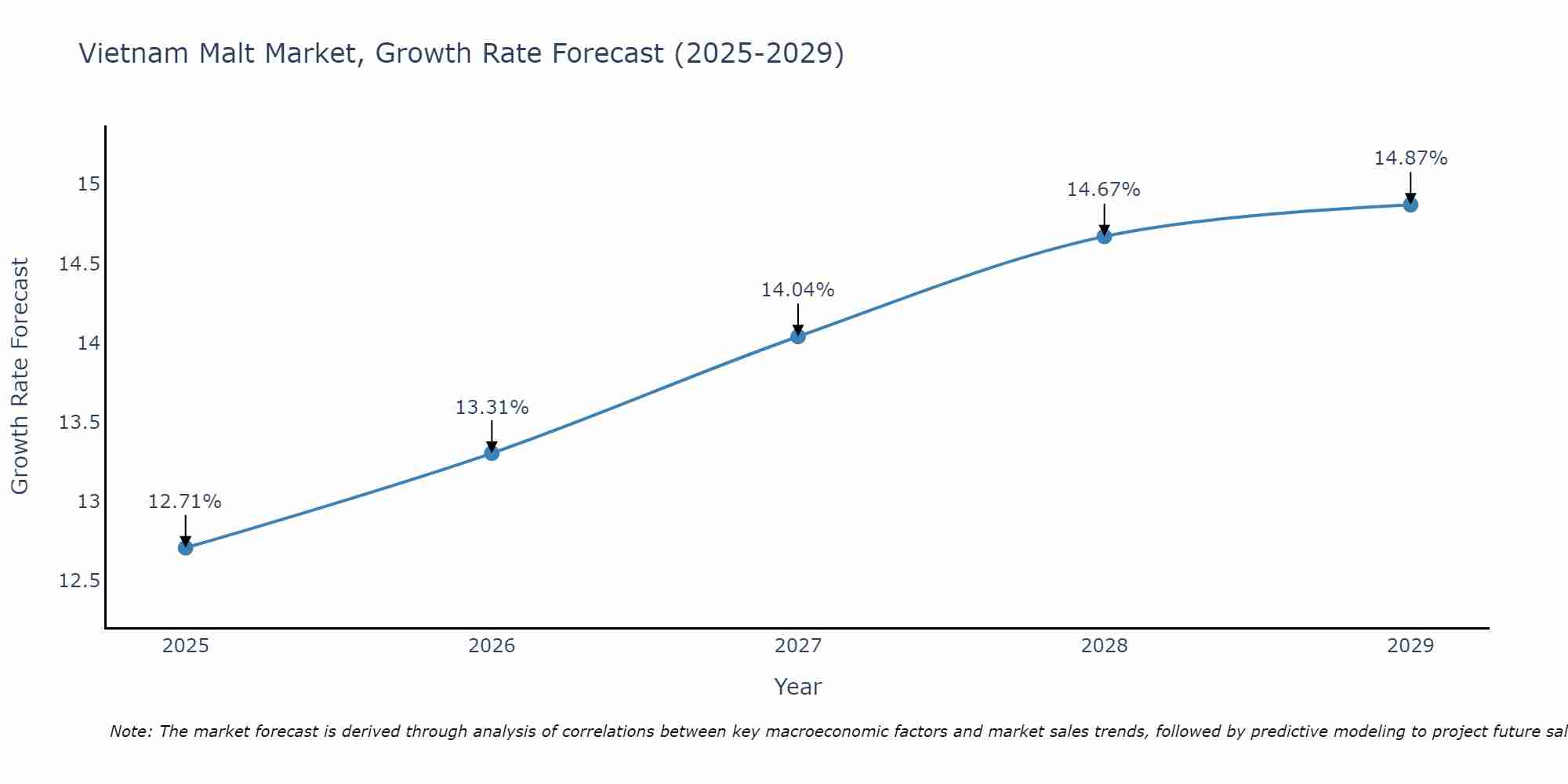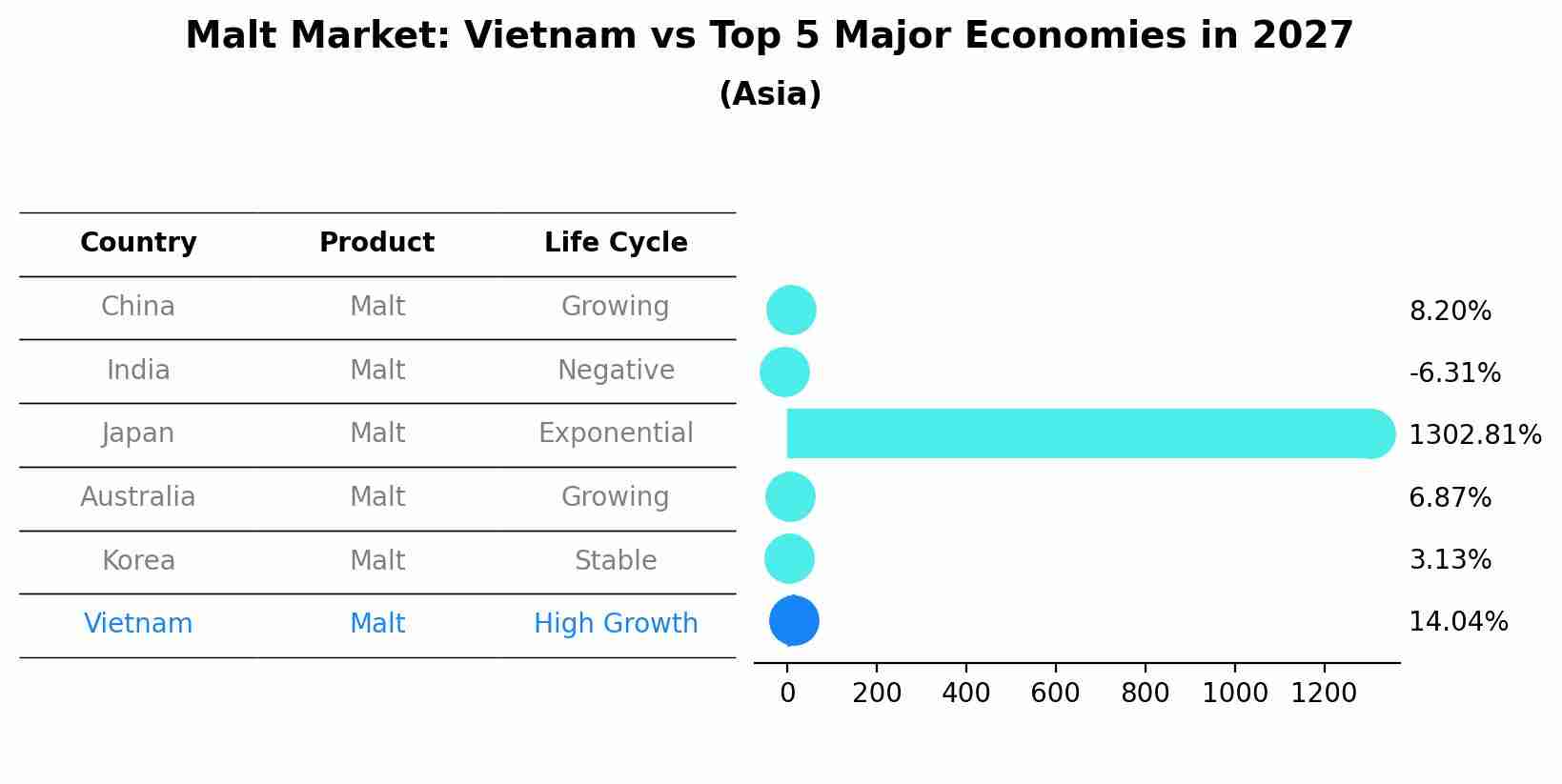Vietnam Malt Market | COVID-19 IMPACT, Analysis, Trends, Companies, Industry, Size, Growth, Share, Revenue, Forecast & Value
| Product Code: ETC179089 | Publication Date: Jan 2022 | Updated Date: Aug 2025 | Product Type: Market Research Report | |
| Publisher: 6Wresearch | No. of Pages: 70 | No. of Figures: 35 | No. of Tables: 5 | |
Vietnam Malt Market Size Growth Rate
The Vietnam Malt Market is poised for steady growth rate improvements from 2025 to 2029. From 12.71% in 2025, the growth rate steadily ascends to 14.87% in 2029.

Malt Market: Vietnam vs Top 5 Major Economies in 2027 (Asia)
In the Asia region, the Malt market in Vietnam is projected to expand at a high growth rate of 14.04% by 2027. The largest economy is China, followed by India, Japan, Australia and South Korea.

Vietnam Malt Market Overview
The Vietnam Malt market is a crucial component of the brewing and distilling industries. Malt, derived from barley or other grains, serves as a primary ingredient in the production of beer and spirits. This market is influenced by factors such as the growth of the beverage industry, consumer preferences for diverse and premium alcoholic products, and the sourcing of high-quality malt. The market dynamics are further shaped by factors such as agricultural practices, global trade in malt products, and the regulatory landscape governing the production and sale of alcoholic beverages in Vietnam.
Drivers of the Market
The Vietnam Malt market is experiencing growth due to several driving factors. One significant driver is the thriving beverage industry, with malt being a crucial ingredient in the production of beer, malted drinks, and malted milk. As the popularity of these beverages continues to rise, so does the demand for malt. Additionally, malt finds application in the food processing industry as a natural sweetener and flavor enhancer, which has contributed to its market growth. The support of the agricultural sector and malt barley cultivation in Vietnam has ensured a consistent supply of malt, further bolstering its market.
Challenges of the Market
The Vietnam Malt market confronts challenges primarily driven by the brewing and beverage industry`s limited growth. The demand for malt is closely tied to the production of beer and other alcoholic beverages, and strict regulations on alcohol advertising and consumption have hindered market expansion. Additionally, malt production itself requires precise quality control and specific processing conditions. As such, producers need to invest in technology and quality assurance to meet stringent standards and maintain consistency in their malt products. Moreover, diversifying applications of malt beyond brewing, such as in the food and non-alcoholic beverage industries, can help mitigate these challenges.
COVID 19 Impact on the Market
The Vietnam Malt Market experienced the impact of the COVID-19 pandemic, with disruptions in the brewing and beverage industry affecting malt production and consumption. Closure of bars, restaurants, and entertainment venues led to a decline in demand for malt-based beverages. The market responded by diversifying product offerings, exploring alternative distribution channels, and emphasizing the resilience of the brewing industry. As the economy gradually reopens, the Malt Market in Vietnam is poised for recovery, with a focus on adapting to changing consumer habits and preferences.
Key Players in the Market
The malt market in Vietnam is characterized by the presence of leading players who shape the industry`s dynamics and contribute significantly to its growth. Key market influencers include MaltMasters Vietnam, BrewHarvest Ltd., and CraftMalt Co. Renowned for their expertise in malt production, adherence to brewing standards, and commitment to quality, these players play a vital role in meeting the needs of the brewing and food industries in Vietnam. Their influence is instrumental in driving innovation and competitiveness within the malt market.
Key Highlights of the Report:
- Vietnam Malt Market Outlook
- Market Size of Vietnam Malt Market, 2023
- Forecast of Vietnam Malt Market, 2030
- Historical Data and Forecast of Vietnam Malt Revenues & Volume for the Period 2020-2030
- Vietnam Malt Market Trend Evolution
- Vietnam Malt Market Drivers and Challenges
- Vietnam Malt Price Trends
- Vietnam Malt Porter's Five Forces
- Vietnam Malt Industry Life Cycle
- Historical Data and Forecast of Vietnam Malt Market Revenues & Volume By Type for the Period 2020-2030
- Historical Data and Forecast of Vietnam Malt Market Revenues & Volume By Malt for the Period 2020-2030
- Historical Data and Forecast of Vietnam Malt Market Revenues & Volume By Malt Extract for the Period 2020-2030
- Historical Data and Forecast of Vietnam Malt Market Revenues & Volume By Malt Extract Powder for the Period 2020-2030
- Historical Data and Forecast of Vietnam Malt Market Revenues & Volume By Malt Flour for the Period 2020-2030
- Historical Data and Forecast of Vietnam Malt Market Revenues & Volume By Barley malt for the Period 2020-2030
- Historical Data and Forecast of Vietnam Malt Market Revenues & Volume By Wheat malt for the Period 2020-2030
- Historical Data and Forecast of Vietnam Malt Market Revenues & Volume By Rye malt for the Period 2020-2030
- Historical Data and Forecast of Vietnam Malt Market Revenues & Volume By Application for the Period 2020-2030
- Historical Data and Forecast of Vietnam Malt Market Revenues & Volume By Beer Industry for the Period 2020-2030
- Historical Data and Forecast of Vietnam Malt Market Revenues & Volume By Whisky Distilleries for the Period 2020-2030
- Historical Data and Forecast of Vietnam Malt Market Revenues & Volume By Food industry for the Period 2020-2030
- Historical Data and Forecast of Vietnam Malt Market Revenues & Volume By Beverages for the Period 2020-2030
- Historical Data and Forecast of Vietnam Malt Market Revenues & Volume By Pharmaceutical industry for the Period 2020-2030
- Vietnam Malt Import Export Trade Statistics
- Market Opportunity Assessment By Type
- Market Opportunity Assessment By Application
- Vietnam Malt Top Companies Market Share
- Vietnam Malt Competitive Benchmarking By Technical and Operational Parameters
- Vietnam Malt Company Profiles
- Vietnam Malt Key Strategic Recommendations
Frequently Asked Questions About the Market Study (FAQs):
1 Executive Summary |
2 Introduction |
2.1 Key Highlights of the Report |
2.2 Report Description |
2.3 Market Scope & Segmentation |
2.4 Research Methodology |
2.5 Assumptions |
3 Vietnam Malt Market Overview |
3.1 Vietnam Country Macro Economic Indicators |
3.2 Vietnam Malt Market Revenues & Volume, 2020 & 2030F |
3.3 Vietnam Malt Market - Industry Life Cycle |
3.4 Vietnam Malt Market - Porter's Five Forces |
3.5 Vietnam Malt Market Revenues & Volume Share, By Type, 2020 & 2030F |
3.6 Vietnam Malt Market Revenues & Volume Share, By Application, 2020 & 2030F |
4 Vietnam Malt Market Dynamics |
4.1 Impact Analysis |
4.2 Market Drivers |
4.2.1 Increasing demand for craft beer and specialty malt products |
4.2.2 Growth in the food and beverage industry, particularly in the brewing sector |
4.2.3 Rising disposable income and changing consumer preferences towards premium malt products |
4.3 Market Restraints |
4.3.1 Fluctuations in raw material prices, such as barley |
4.3.2 Regulatory challenges and compliance requirements in the malt industry |
4.3.3 Competition from imported malt products impacting domestic market growth |
5 Vietnam Malt Market Trends |
6 Vietnam Malt Market, By Types |
6.1 Vietnam Malt Market, By Type |
6.1.1 Overview and Analysis |
6.1.2 Vietnam Malt Market Revenues & Volume, By Type, 2020-2030F |
6.1.3 Vietnam Malt Market Revenues & Volume, By Malt, 2020-2030F |
6.1.4 Vietnam Malt Market Revenues & Volume, By Malt Extract, 2020-2030F |
6.1.5 Vietnam Malt Market Revenues & Volume, By Malt Extract Powder, 2020-2030F |
6.1.6 Vietnam Malt Market Revenues & Volume, By Malt Flour, 2020-2030F |
6.1.7 Vietnam Malt Market Revenues & Volume, By Barley malt, 2020-2030F |
6.1.8 Vietnam Malt Market Revenues & Volume, By Wheat malt, 2020-2030F |
6.2 Vietnam Malt Market, By Application |
6.2.1 Overview and Analysis |
6.2.2 Vietnam Malt Market Revenues & Volume, By Beer Industry , 2020-2030F |
6.2.3 Vietnam Malt Market Revenues & Volume, By Whisky Distilleries, 2020-2030F |
6.2.4 Vietnam Malt Market Revenues & Volume, By Food industry , 2020-2030F |
6.2.5 Vietnam Malt Market Revenues & Volume, By Beverages , 2020-2030F |
6.2.6 Vietnam Malt Market Revenues & Volume, By Pharmaceutical industry, 2020-2030F |
7 Vietnam Malt Market Import-Export Trade Statistics |
7.1 Vietnam Malt Market Export to Major Countries |
7.2 Vietnam Malt Market Imports from Major Countries |
8 Vietnam Malt Market Key Performance Indicators |
8.1 Average selling price of malt products |
8.2 Number of craft breweries using malt in their production processes |
8.3 Percentage of malt used in the total brewing industry output |
9 Vietnam Malt Market - Opportunity Assessment |
9.1 Vietnam Malt Market Opportunity Assessment, By Type, 2020 & 2030F |
9.2 Vietnam Malt Market Opportunity Assessment, By Application, 2020 & 2030F |
10 Vietnam Malt Market - Competitive Landscape |
10.1 Vietnam Malt Market Revenue Share, By Companies, 2023 |
10.2 Vietnam Malt Market Competitive Benchmarking, By Operating and Technical Parameters |
11 Company Profiles |
12 Recommendations |
13 Disclaimer |
- Single User License$ 1,995
- Department License$ 2,400
- Site License$ 3,120
- Global License$ 3,795
Search
Related Reports
- UAE Building Thermal Insulation Market Outlook (2025-2031) | Revenue, Companies, Share, Trends, Growth, Size, Forecast, Industry, Analysis & Value
- Portugal Electronic Document Management Market (2025-2031) | Strategy, Consumer Insights, Analysis, Investment Trends, Opportunities, Growth, Size, Share, Industry, Revenue, Segments, Value, Segmentation, Supply, Forecast, Restraints, Outlook, Competition, Drivers, Trends, Demand, Pricing Analysis, Competitive, Strategic Insights, Companies, Challenges
- France Electronic Document Management Market (2025-2031) | Strategy, Consumer Insights, Analysis, Investment Trends, Opportunities, Growth, Size, Share, Industry, Revenue, Segments, Value, Segmentation, Supply, Forecast, Restraints, Outlook, Competition, Drivers, Trends, Demand, Pricing Analysis, Competitive, Strategic Insights, Companies, Challenges
- Portugal Occupational Health & Safety Services Market (2025-2031) | Strategy, Consumer Insights, Analysis, Investment Trends, Opportunities, Growth, Size, Share, Industry, Revenue, Segments, Value, Segmentation, Supply, Forecast, Restraints, Outlook, Competition, Drivers, Trends, Demand, Pricing Analysis, Competitive, Strategic Insights, Companies, Challenges
- Netherlands Occupational Health and Safety Services Market (2025-2031) | Strategy, Consumer Insights, Analysis, Investment Trends, Opportunities, Growth, Size, Share, Industry, Revenue, Segments, Value, Segmentation, Supply, Forecast, Restraints, Outlook, Competition, Drivers, Trends, Demand, Pricing Analysis, Competitive, Strategic Insights, Companies, Challenges
- Belgium and Luxembourg Facility Management Market (2025-2031) | Strategy, Consumer Insights, Analysis, Investment Trends, Opportunities, Growth, Size, Share, Industry, Revenue, Segments, Value, Segmentation, Supply, Forecast, Restraints, Outlook, Competition, Drivers, Trends, Demand, Pricing Analysis, Competitive, Strategic Insights, Companies, Challenges
- Russia Women Intimate Apparel Market (2025-2031) | Strategy, Consumer Insights, Analysis, Investment Trends, Opportunities, Growth, Size, Share, Industry, Revenue, Segments, Value, Segmentation, Supply, Forecast, Restraints, Outlook, Competition, Drivers, Trends, Demand, Pricing Analysis, Competitive, Strategic Insights, Companies, Challenges
- Africa Chocolate Market (2025-2031) | Size, Share, Trends, Growth, Revenue, Analysis, Forecast, industry & Outlook
- Global Hydroxychloroquine And Chloroquine Market (2025-2031) | Industry, Trends, Size, Outlook, Growth, Value, Companies, Revenue, Analysis, Share, Forecast
- Saudi Arabia Plant Maintenance Market (2025-2031) | Industry, Size, Growth, Revenue, Value, Companies, Forecast, Analysis, Share & Trends
Industry Events and Analyst Meet
Our Clients
Whitepaper
- Middle East & Africa Commercial Security Market Click here to view more.
- Middle East & Africa Fire Safety Systems & Equipment Market Click here to view more.
- GCC Drone Market Click here to view more.
- Middle East Lighting Fixture Market Click here to view more.
- GCC Physical & Perimeter Security Market Click here to view more.
6WResearch In News
- Doha a strategic location for EV manufacturing hub: IPA Qatar
- Demand for luxury TVs surging in the GCC, says Samsung
- Empowering Growth: The Thriving Journey of Bangladesh’s Cable Industry
- Demand for luxury TVs surging in the GCC, says Samsung
- Video call with a traditional healer? Once unthinkable, it’s now common in South Africa
- Intelligent Buildings To Smooth GCC’s Path To Net Zero













